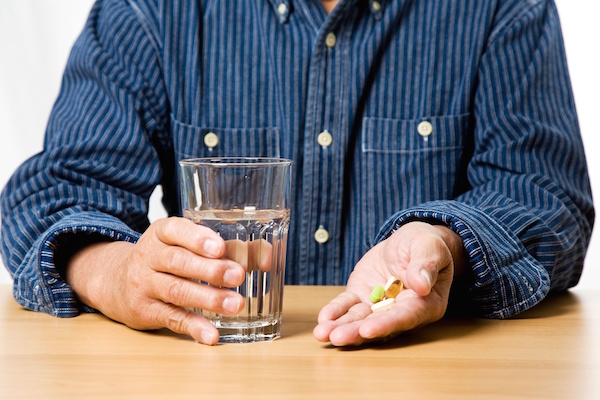
MONDAY, April 22 (HealthDay News) — A pill may work as well as a puff when it comes to using marijuana to treat pain, according to a small but carefully controlled new study. Pain relief from pills may last longer, however, and may not leave people feeling as high as they do after they smoke the drug.
Medical marijuana is now legal in 18 states and the District of Columbia, according to the nonprofit group ProCon.org. Surveys show pain is one of the main reasons doctors prescribe it. But studies testing marijuana as a pain reliever have had mixed results. Some have shown that it works as well as mild opioid (narcotic) pain relievers like codeine, while others have indicated that the drug might actually make pain worse.
To learn more, researchers at the Substance Use Research Center of the New York State Psychiatric Institute pitted two strengths of smoked marijuana against two strengths of the drug dronabinol, which contains tetrahydrocannabinol, or THC, the same active ingredient as in marijuana plants.
Dronabinol has been FDA-approved since 1985 to treat the nausea and loss of appetite that commonly afflict patients with cancer and AIDS. Less is known about its effects on pain.
For the government-sponsored study, researchers recruited 30 healthy, pain-free men and women who were already regular marijuana smokers.
During five experimental sessions, participants took a capsule and then 45 minutes later smoked a marijuana cigarette. The capsules contained either an inactive placebo, or 10 milligrams or 20 milligrams of dronabinol. The cigarettes were specially made by the U.S. National Institute on Drug Abuse, which funded the study. Cigarettes were standardized to contain marijuana with no THC, a low dose of the drug or a higher dose.
People in the study never knew whether they were smoking or swallowing the drug or how strong the dose was. Researchers made sure they never got a double hit of the drug during the same session.
The testing days were spaced at least two days apart, and participants were asked to refrain from smoking the night before their lab visits.
Several times during the sessions, researchers had each person place their hands in a water bath kept just above freezing temperatures. They measured how long it took study participants to feel pain and then how long they were able to tolerate the pain before they yanked their hand out of the water. Participants also answered questions about how intensely they felt the pain during the experiments and how high they felt.
When researchers tallied their data, they found that both the smoked drug and the pill were about equally effective at controlling pain.
After smoking the strongest cigarettes or taking the highest strength of the pill, it took people an average of about 12 to 13 seconds longer to report feeling pain from the cold water compared to when they took the placebos. Both forms of the drug also significantly increased pain tolerance, the amount of time a person was able to stand the pain before they pulled their hand out of the cold water.
Additionally, study participants reported that their pain was decreased after they smoked either strength of marijuana cigarette and after they took the highest strength of the dronabinol capsules.
The biggest differences between the puffs and the pills had to do with how long it took the drug to work and how high people felt after they used it.
Researchers found that pain relief peaked about 15 minutes after people smoked the marijuana and wore off relatively quickly. The pills took longer to work, but the pain relief lasted three to four hours.
Participants also reported feeling much higher after smoking the drug compared to when they swallowed it. The feeling of being high usually outlasted any pain relief.
“If you think about it, if you’re someone who’s dealing with chronic pain, you’re going to have to be smoking several times a day, and for a lot of people that would not be feasible,” said study author Ziva Cooper, an assistant professor of clinical neurobiology at Columbia University, in New York City.
Cooper also noted that swallowing a pill might be a safer way to take the drug than smoking it. There’s some concern, though scant evidence, that smoking marijuana might increase the risk for lung cancer.
Dr. Gary Reisfield, an assistant professor of addiction medicine and chief of pain management services at the University of Florida College of Medicine, in Gainesville, praised the study for being “well-conceived and meticulously designed.”
He said the research should help doctors and patients better understand how to use the drug.
“Smoked cannabis works faster, but oral THC works longer. For the management of chronic pain and other symptoms, the duration of action is often more important than the rapidity of onset. It is more convenient, and often more desirable, to administer a medication two or three times daily rather [than] every two or three hours,” said Reisfield, who was not involved in the research.
When it comes to price, it costs somewhat more to swallow average doses of the drug than to smoke it, according to ProCon.org. At an average dose of two joints a day, it costs about $514 a month to smoke marijuana. The usual dose of dronabinol, which is the generic form of the drug Marinol, costs about $678 a month.
But dronabinol is often covered by insurance, so an insured patient would pay far less, between $15 and $30 each month for their prescription.
The study was published April 22 in the journal Neuropsychopharmacology.
More information
For more on marijuana, visit the U.S. National Institute on Drug Abuse.

